

AlphaLISA SureFire Ultra Human and Mouse Phospho-Rb (Thr826) Detection Kit, 10,000 Assay Points
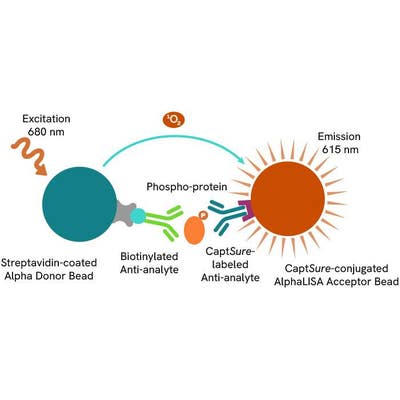

AlphaLISA SureFire Ultra Human and Mouse Phospho-Rb (Thr826) Detection Kit, 10,000 Assay Points



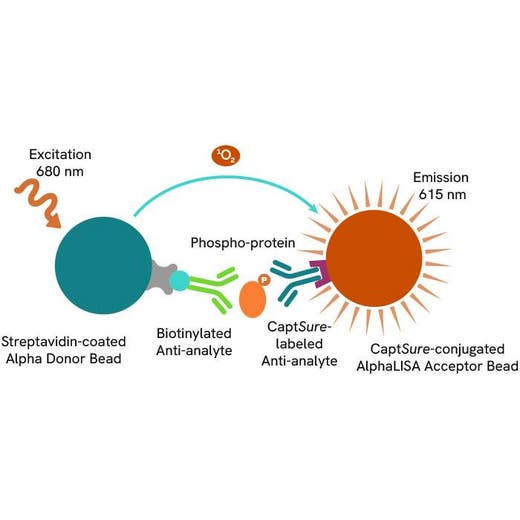


The AlphaLISA™ SureFire® Ultra™ Human and Mouse Phospho-Rb (Thr826) assay is a sandwich immunoassay for quantitative detection of phospho-Rb in cellular lysates using Alpha Technology.
| Feature | Specification |
|---|---|
| Application | Protein Quantification |
The AlphaLISA™ SureFire® Ultra™ Human and Mouse Phospho-Rb (Thr826) assay is a sandwich immunoassay for quantitative detection of phospho-Rb in cellular lysates using Alpha Technology.



AlphaLISA SureFire Ultra Human and Mouse Phospho-Rb (Thr826) Detection Kit, 10,000 Assay Points



AlphaLISA SureFire Ultra Human and Mouse Phospho-Rb (Thr826) Detection Kit, 10,000 Assay Points



Product information
Overview
Retinoblastoma protein (Rb) is a tumor suppressor protein that regulates the cell cycle by controlling the transition from the G1 to the S phase. Rb achieves this by binding to and inhibiting E2F transcription factors, preventing the transcription of genes required for DNA replication. Loss or mutation of Rb leads to uncontrolled cell proliferation and is associated with various cancers, including retinoblastoma, osteosarcoma, and small cell lung cancer.
The AlphaLISA SureFire Ultra Human and Mouse Phospho-Rb (Thr826) Detection Kit is a sandwich immunoassay for the quantitative detection of phospho-Rb (Thr826) in cellular lysates, using Alpha Technology.
Formats:
- The HV (high volume) kit contains reagents to run 100 wells in 96-well format, using a 60 μL reaction volume.
- The 500-point kit contains enough reagents to run 500 wells in 384-well format, using a 20 μL reaction volume.
- The 10,000-point kit contains enough reagents to run 10,000 wells in 384-well format, using a 20 μL reaction volume.
- The 50,000-point kit contains enough reagents to run 50,000 wells in 384-well format, using a 20 μL reaction volume.
AlphaLISA SureFire Ultra kits are compatible with:
- Cell and tissue lysates
- Antibody modulators
- Biotherapeutic antibodies
Alpha SureFire Ultra kits can be used for:
- Cellular kinase assays
- Receptor activation studies
- Screening
Specifications
| Application |
Protein Quantification
|
|---|---|
| Automation Compatible |
Yes
|
| Brand |
AlphaLISA SureFire Ultra
|
| Detection Modality |
Alpha
|
| Host Species |
Human
Mouse
|
| Molecular Modification |
Phosphorylation
|
| Product Group |
Kit
|
| Shipping Conditions |
Shipped in Blue Ice
|
| Target |
Rb
|
| Target Class |
Phosphoproteins
|
| Target Species |
Human
|
| Technology |
Alpha
|
| Therapeutic Area |
Oncology
|
| Unit Size |
10,000 assay points
|
Video gallery

AlphaLISA SureFire Ultra Human and Mouse Phospho-Rb (Thr826) Detection Kit, 10,000 Assay Points

AlphaLISA SureFire Ultra Human and Mouse Phospho-Rb (Thr826) Detection Kit, 10,000 Assay Points

How it works
Phospho-AlphaLISA SureFire Ultra assay principle
The Phospho-AlphaLISA SureFire Ultra assay measures a protein target when phosphorylated at a specific residue.
The assay uses two antibodies which recognize the phospho epitope and a distal epitope on the targeted protein. AlphaLISA assays require two bead types: Acceptor and Donor beads. Acceptor beads are coated with a proprietary CaptSure™ agent to specifically immobilize the assay specific antibody, labeled with a CaptSure™ tag. Donor beads are coated with streptavidin to capture one of the detection antibodies, which is biotinylated. In the presence of phosphorylated protein, the two antibodies bring the Donor and Acceptor beads in close proximity whereby the singlet oxygen transfers energy to excite the Acceptor bead, allowing the generation of a luminescent Alpha signal. The amount of light emission is directly proportional to the quantity of phosphoprotein present in the sample.

Phospho-AlphaLISA SureFire Ultra two-plate assay protocol
The two-plate protocol involves culturing and treating the cells in a 96-well plate before lysis, then transferring lysates into a 384-well OptiPlate™ plate before the addition of Phospho-AlphaLISA SureFire Ultra detection reagents. This protocol permits the cells' viability and confluence to be monitored. In addition, lysates from a single well can be used to measure multiple targets.
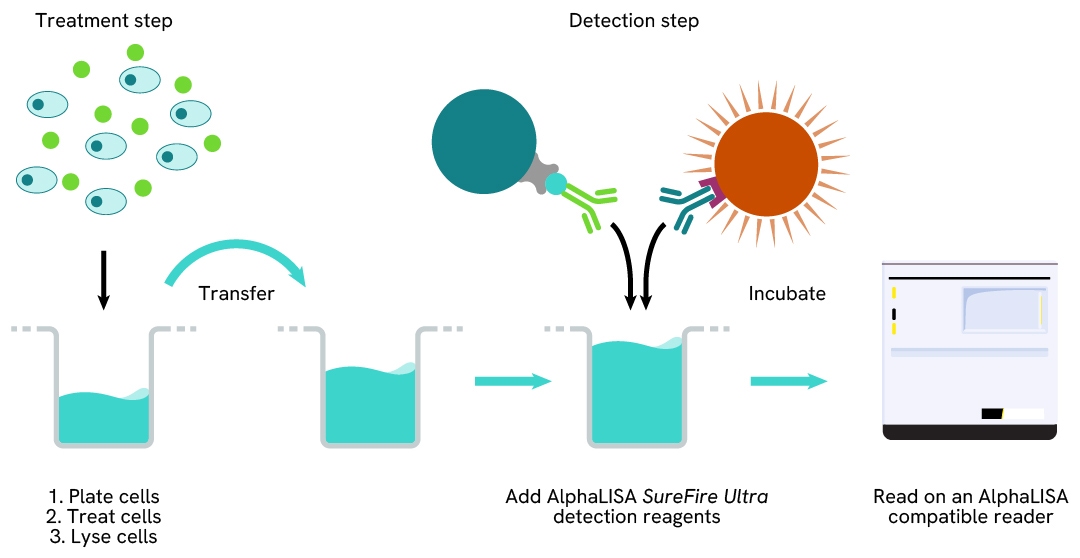
Phospho-AlphaLISA SureFire Ultra one-plate assay protocol
Detection of Phosphorylated target protein with AlphaLISA SureFire Ultra reagents can be performed in a single plate used for culturing, treatment, and lysis. No washing steps are required. This HTS designed protocol allows for miniaturization while maintaining AlphaLISA SureFire Ultra quality.
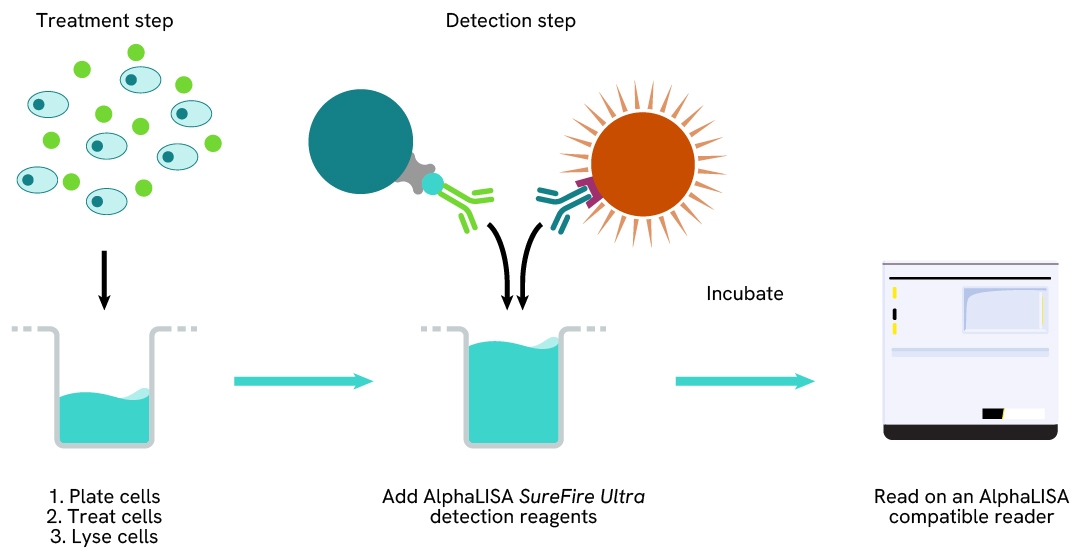
Assay validation
Activation of Phospho Rb (Thr826) in NRG1 treated cells
MCF7 cells were seeded in a 96-well plate (40,000 cells/well) in complete medium, and incubated overnight at 37°C, 5% CO2. The cells were pre-treated with 20 µM Wortmannin in serum free medium for 2 hours, followed by treatment with increasing concentrations of Neuregulin 1 (NRG1) in serum free medium for 24 hours.
After treatment, the cells were lysed with 100 µL of Lysis Buffer for 10 minutes at RT with shaking (350 rpm). Rb Phospho (Thr826) and Total levels were evaluated using respective AlphaLISA SureFire Ultra assays. For the detection step, 10 µL of cell lysate (approximately 4,000 cells) were transferred into a 384-well white OptiPlate, followed by 5 µL of Acceptor mix and incubated for 1 hour at RT. Finally, 5 µL of Donor mix was then added to each well and incubated for 1 hour at RT in the dark. The plate was read on an Envision using standard AlphaLISA settings.
Neuregulin 1 treatment in MCF7 cells triggered a dose-dependent increase in levels of Phospho (Thr826) and Total Rb.
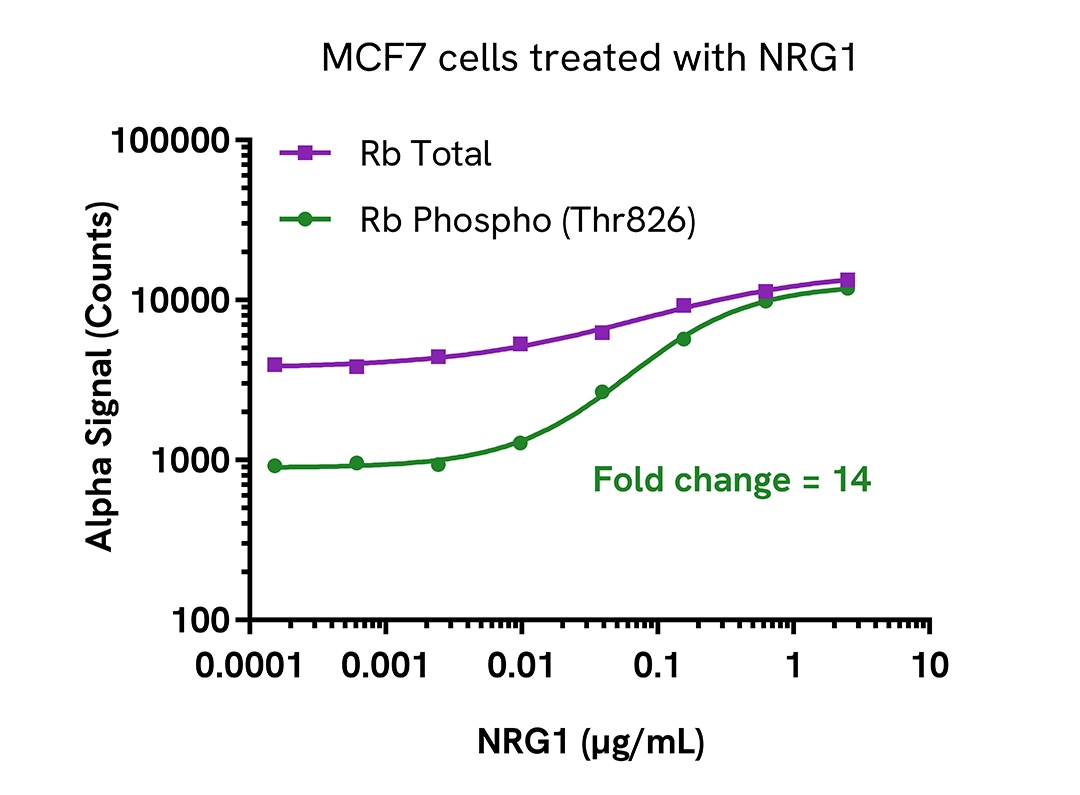
Decrease of Phospho Rb (Thr826) in Palbociclib treated cells
MCF7 cells were seeded in a 96-well plate (40,000 cells/well) in complete medium, and incubated overnight at 37°C, 5% CO2. The cells were treated with increasing concentrations of Palbociclib for 24 hours.
After treatment, the cells were lysed with 100 µL of Lysis Buffer for 10 minutes at RT with shaking (350 rpm). Rb Phospho (Thr826) and Total levels were evaluated using respective AlphaLISA SureFire Ultra assays. For the detection step, 10 µL of cell lysate (approximately 4,000 cells) was transferred into a 384-well white OptiPlate, followed by 5 µL of Acceptor mix and incubated for 1 hour at RT. Finally, 5 µL of Donor mix was then added to each well and incubated for 1 hour at RT in the dark. The plate was read on an Envision using standard AlphaLISA settings.
As expected, Palbociclib triggered a dose-dependent decrease in the levels of Phospho Rb (Thr826).
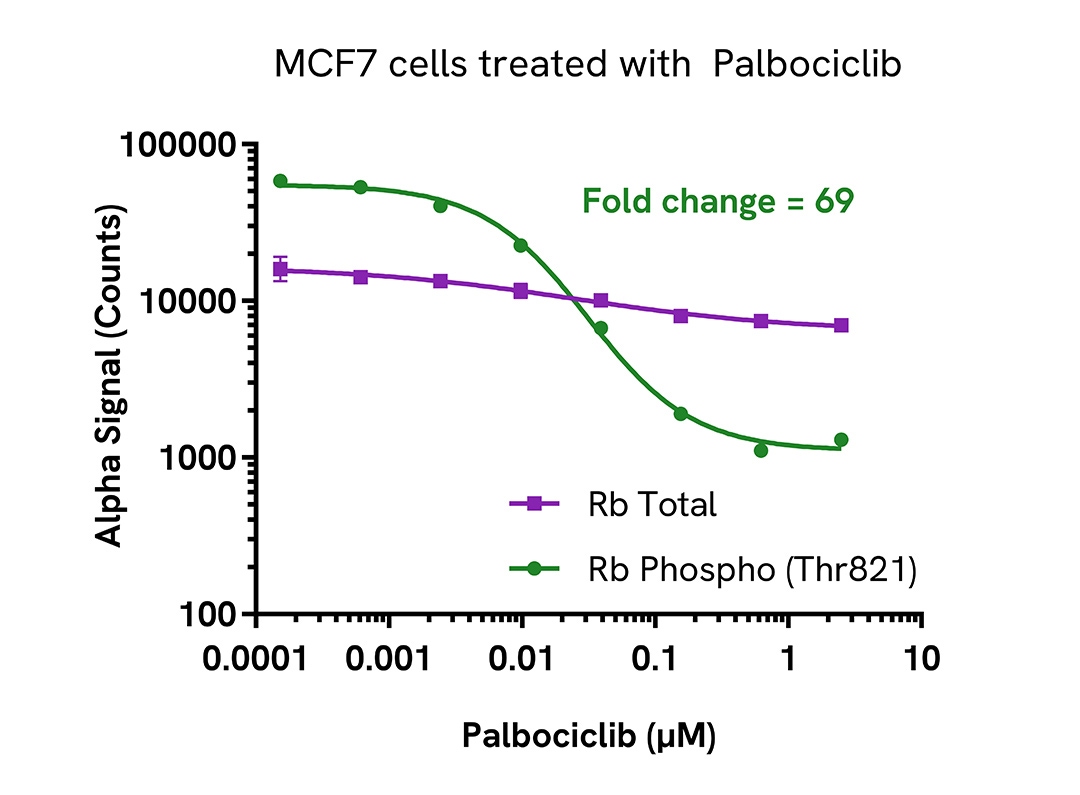
Decrease of Phospho Rb (Thr826) in CDK6 PROTAC treated cells
MCF7 cells were seeded in a 96-well plate (40,000 cells/well) in complete medium, and incubated overnight at 37°C, 5% CO2. The cells were treated with increasing concentrations of BSJ-03-123 (CDK6 PROTAC) for 24 hours.
After treatment, the cells were lysed with 100 µL of lysis buffer for 10 minutes at RT with shaking (350 rpm). Rb Phospho (Thr826) and Cofilin Total levels were evaluated using respective AlphaLISA SureFire Ultra assays. For the detection step, 10 µL of cell lysate (approximately 4,000 cells or 800 cells for Cofilin Total) was transferred into a 384-well white OptiPlate, followed by 5 µL of Acceptor mix and incubated for 1 hour at RT. Finally, 5 µL of Donor mix was then added to each well and incubated for 1 hour at RT in the dark. The plate was read on an Envision using standard AlphaLISA settings.
As expected, the CDK6 PROTAC, BSJ-03-123, induced a significant decrease in the levels of Phospho Rb (Thr826) while Total Cofilin levels remained unchanged.

Resources
Are you looking for resources, click on the resource type to explore further.
The definitive guide for setting up a successful AlphaLISA SureFire Ultra assay
Several biological processes are regulated by...
Discover Alpha SureFire® Ultra™ assays, the no-wash cellular kinase assays leveraging Revvity's exclusive bead-based technology...
This document includes detailed tables listing HTRF™, AlphaLISA™ SureFire® Ultra™, and Alpha SureFire® Ultra™ Multiplex assays...


How can we help you?
We are here to answer your questions.






























